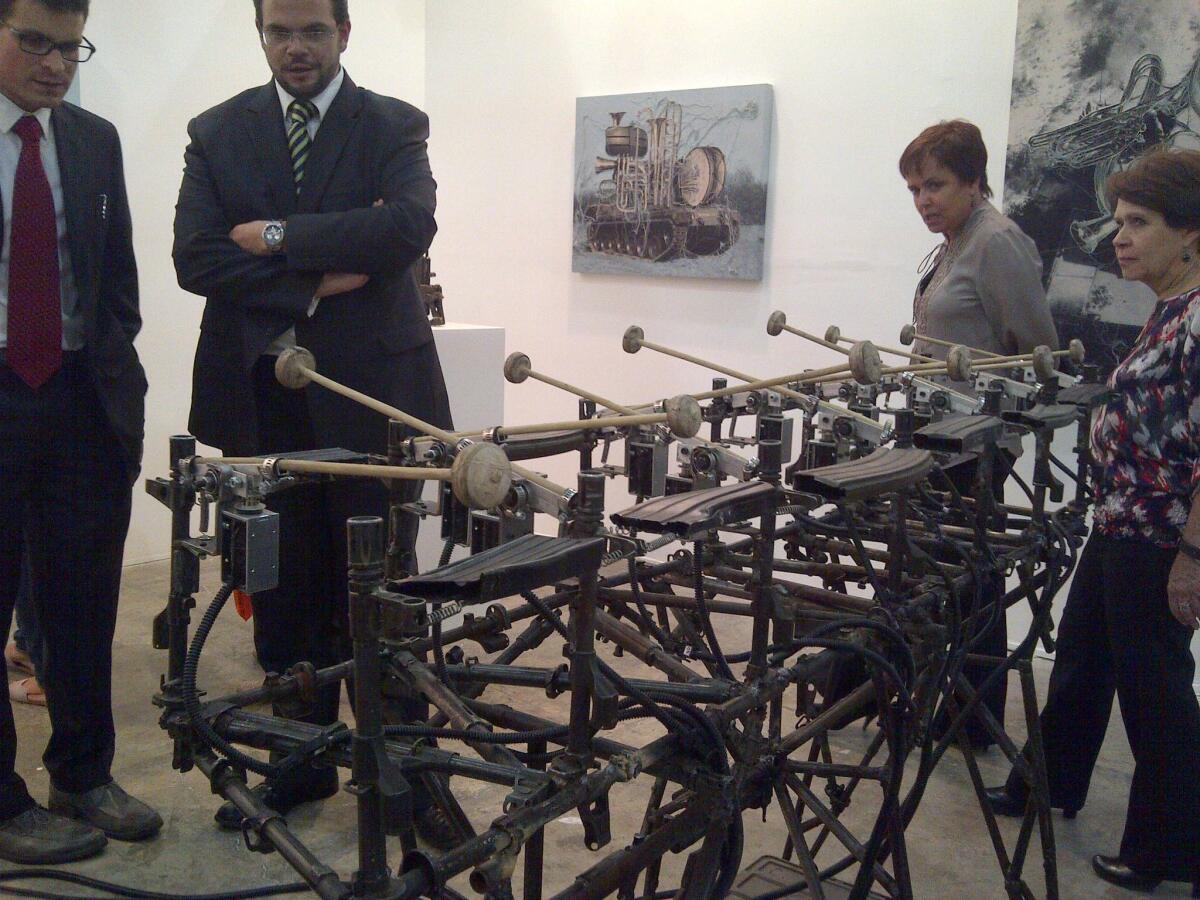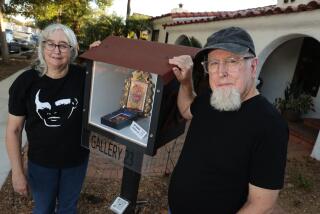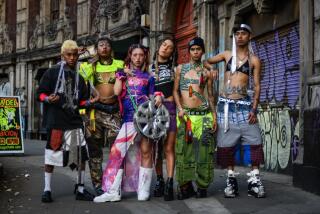Art market doldrums exhibited at Mexico City’s annual bazaar

- Share via
MEXICO CITY -- Skull motifs. Dollar bills pasted on a wall. Phrases written in neon lights. Figures cut out of photographs. Or, if you like, a bunch of lines on paper.
It’s hardly surprising that the offerings at Zona Maco, the Mexico City contemporary art bazaar that opened its 10th edition Wednesday, tend to look and feel like the art for sale at any other big fair.
Many of the galleries with showcases at the glitzy five-day event are visiting from established art centers like New York or Milan. But the ambition of Zona Maco’s longtime director, Zelika Garcia, is to help build a mature art market in Mexico by cultivating domestic galleries and buyers.
Has it worked? Not entirely.
Numbers on Mexico’s cagey collectors and what they’re spending are hard to come by, and Garcia was not available for an interview. But dedicated fair-goers said that the number of collectors in Mexico City remains small.
By far the biggest local art patron is Eugenio Lopez, heir to Mexico’s Jumex juice fortune and owner of the Jumex Collection, said to be the largest private art collection in Latin America. Housed at a juice-making plant in the Mexico City suburb of Ecatepec, Lopez’s collection is reportedly worth at least $80 million.
On the fair’s opening day, which was attended by Lopez and other noteworthy buyers, including the former mayor of Tijuana, Jorge Hank Rhon, there was much grumbling by dealers, artists and visitors.
There was no Internet connection in the hall at the Banamex convention center and not a lot being handed out for free. No water for sale, but plenty of tequila cocktails.
“Slow,” “pale” and “thin” were some of the words used to describe the scene.
“What bothers me is there’s no real thread,” said Mario Ballesteros, editor of Domus Mexico magazine. “Even the big-name galleries, it’s like they’re just pulling out the inventory, like a garage sale.”
On the bright side, government cultural agencies are becoming more involved, offering special programs and providing venues for Zona Maco events, said Maria Ortiz, director of volunteers at Mexico City’s Museum of Modern Art.
Give the scene more time to grow, Ortiz said. “They have international galleries coming now, and so we can see art from abroad that we couldn’t see otherwise.”
By the afternoon, works were selling briskly. A government cultural official announced the establishment of an $829,000 fund to buy new work for Mexico’s museums.
Prints by the artist and tattooist known as Dr. Lakra, made in his trademark style of embellishing vintage paper nudes, were going for $12,000 apiece at the booth of the local Kurimanzutto gallery. Working musical instruments made out of gun parts from Mexico’s violent drug war, by Pedro Reyes for the Labor gallery, were going for $20,000 and up.
But some of the most interesting events are happening away from Zona Maco. Across town, small galleries, art collectives and pop-up curators are offering a host of intriguing indie exhibits throughout the week.
The group Bucareli ACT brought art viewers to a decaying downtown street Tuesday night where largely disused buildings were turned into venues for sound-art and other shows. A new video by artists Ilan Lieberman and Rafael Ortega juxtaposed clips from the classic film “King Kong” with footage of the arrest of the famously smirking U.S.-born drug lord, Edgar “La Barbie” Valdez.
Also away from the fair, art titan Gabriel Orozco is launching a collection of new works at Kurimanzutto on Saturday, a homecoming of sorts after a retrospective of his art traveled through New York, London and Paris in recent years.
Could Zona Maco be the place where a future Orozco makes a first sale? If market-savvy skills are any indicator, why not?
In the young artists section, Monterrey-based gallery Alternativa Once was showing “TwitterDrumSolo,” a drum-kit that played itself, by 25-year-old Daniel Perez Rios.
A lanky guy in glasses, Perez explained that he used a computer to program the drumming to match surges in tweets about the presidential candidates on the night of last year’s election.
The bass drum, for example, played when tweets mentioned “electoral fraud.”
Asked how much the piece cost, Perez replied: “You’ll have to talk to my dealer.”
ALSO:
Chile exhumes body of poet Pablo Neruda
Worry grows over Mexico vigilante movement
Gay marriage on verge of becoming legal in Uruguay
More to Read
Sign up for Essential California
The most important California stories and recommendations in your inbox every morning.
You may occasionally receive promotional content from the Los Angeles Times.










